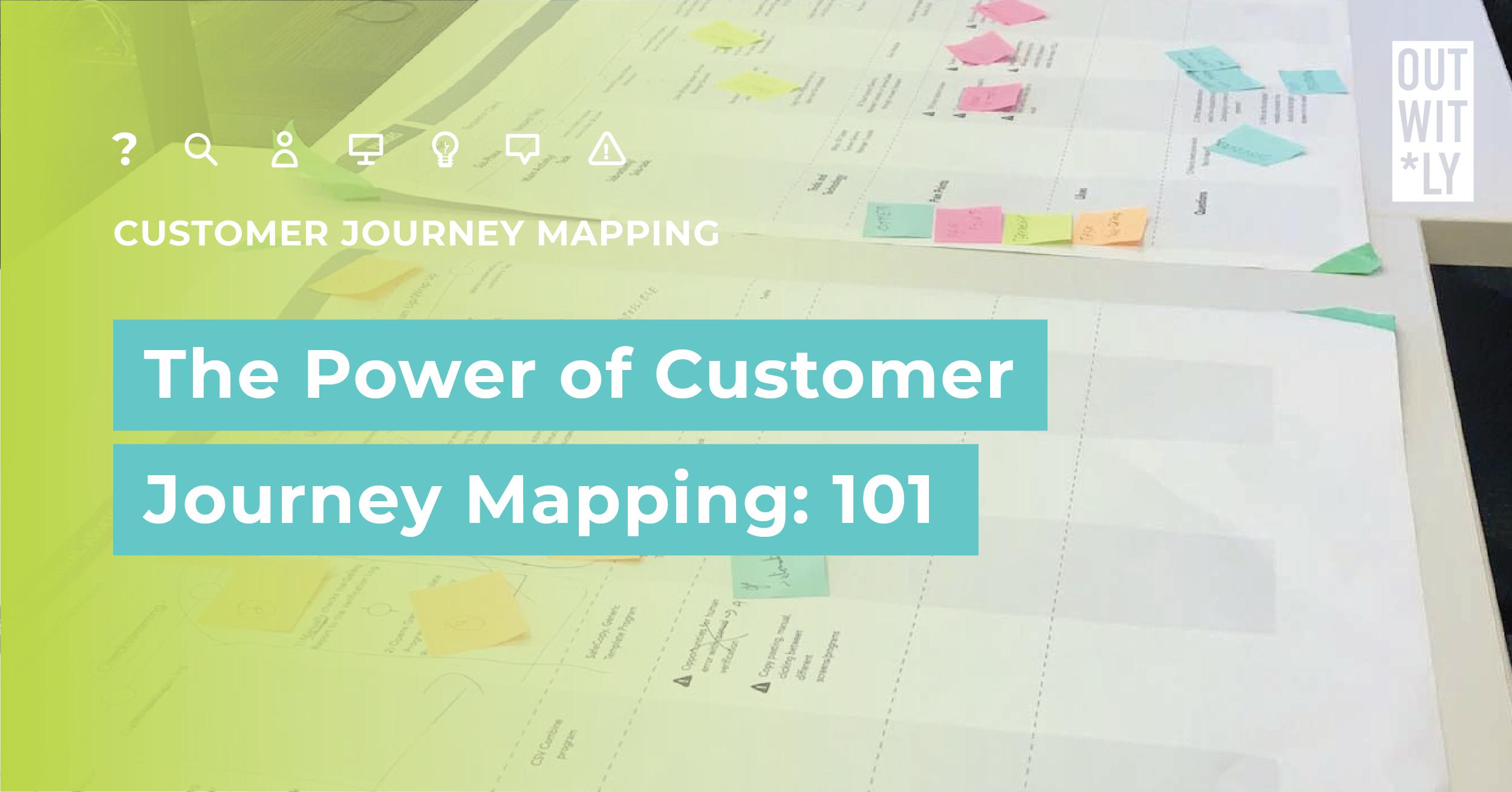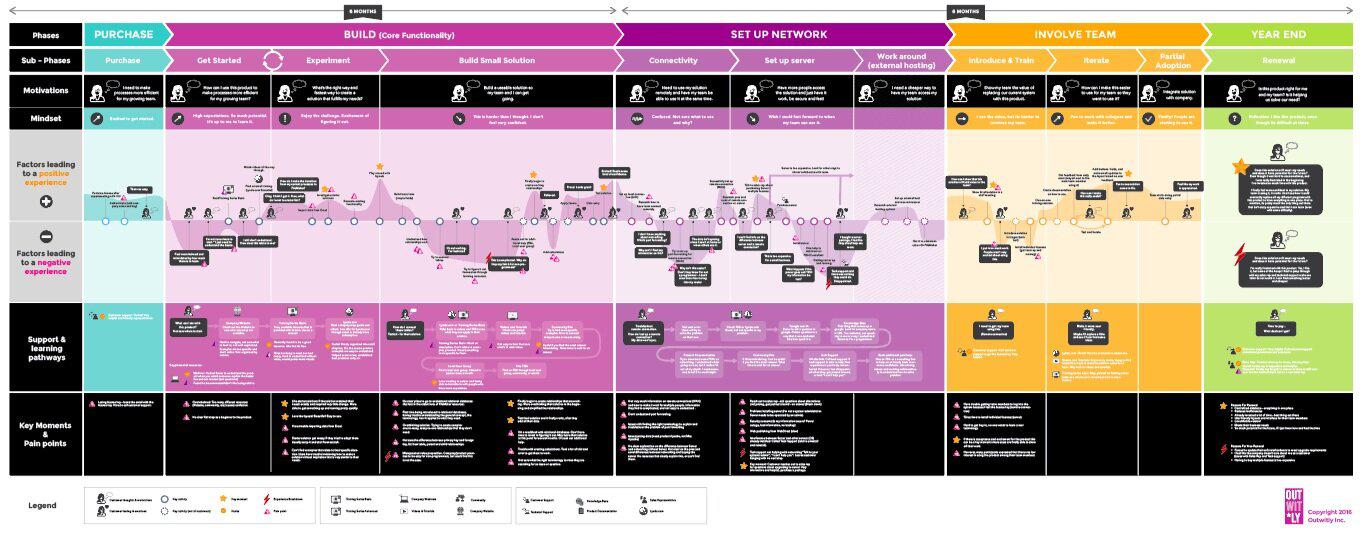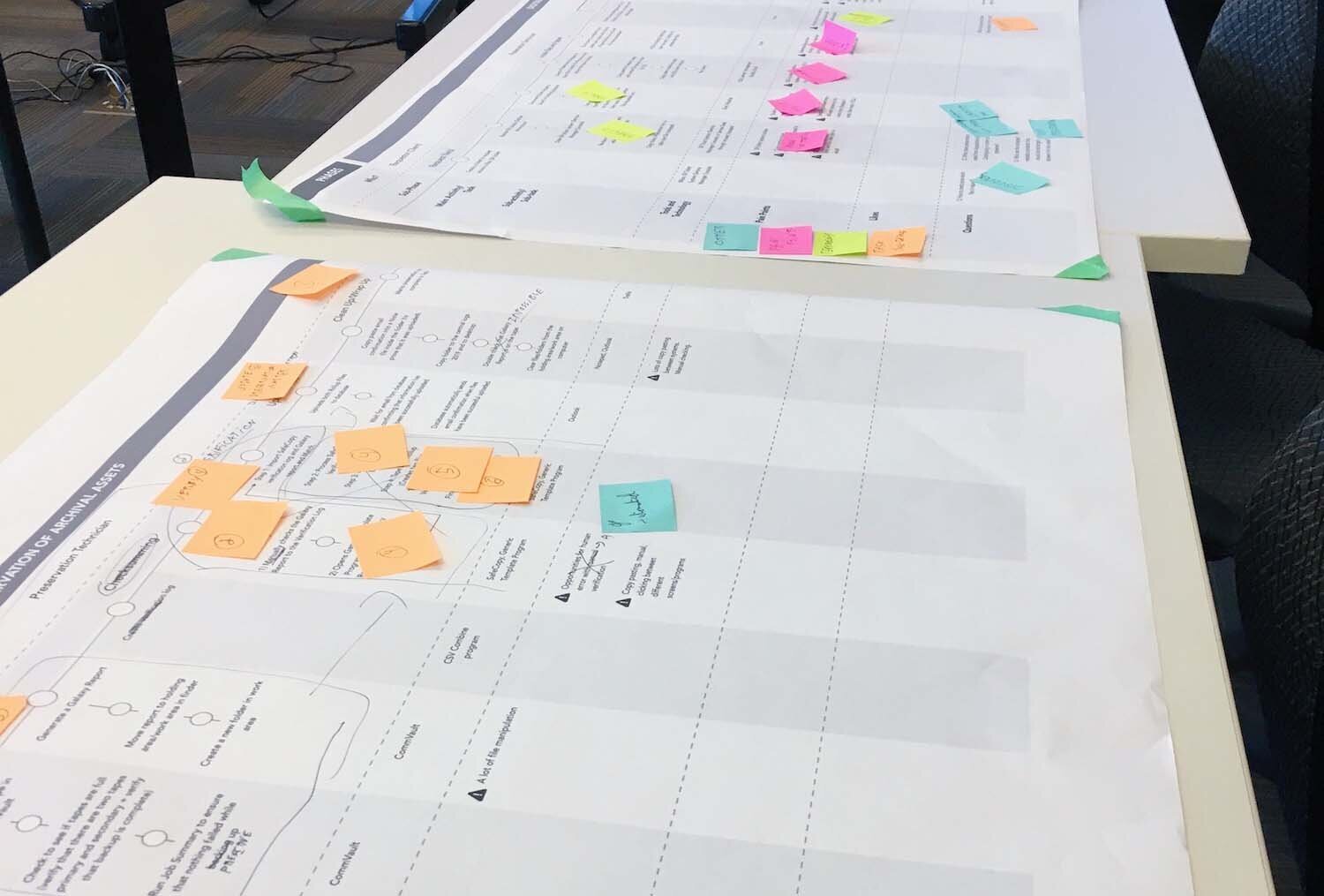We all need maps to show us the way sometimes––the journey is just as important as the destination!
In this three-part blog series, we’re breaking down one of our favourite service design tools: Customer Journey Maps! We will cover:
-
Customer Journey Mapping 101: What are customer journey maps, and why do you need them? (this post)
-
Customer Journey Mapping 201: How to Research and Build a Customer Journey Map
-
Customer Journey Mapping 301: Designing for the future, evolving your map, and making it actionable
This week we’ll introduce you to customer journey mapping, we’ll discuss the different types of maps used in service design, and then we’ll clarify why creating customer journey maps is so ridiculously beneficial for your organization!
What is journey mapping?
Customer Journey Mapping is a powerful storytelling and design tool that will reveal the complexity of your customer/citizen/user experience in a way that is truly easy to understand, by literally mapping it out in front of you. Journey maps, based on research with real people, enable you to clearly see the paths your customers are taking with your organization, products, and services (their “Current State” Journey), in order to better envision, build, and re-route their experiences and paths into the “Ideal” or “Future State” Journey.
With journey mapping, you can identify your customers’ major pain points as well as key areas for opportunity and improvement, and with this research well in-hand, you and your team can make a prioritized action plan and roadmap for the future.
Why are journey maps important?
Journey maps are crucial business tools for many reasons. Not only is the market tough and competition high, but user expectations are increasing every day. Customers today expect beautiful, easy-to-navigate apps–and this expectation of ease and intolerance for “frustrating” experiences has also bled into other sectors…specifically, their non-digital and physical interactions with services.
Brand loyalty is also more precarious than ever. Simple interactions with companies now entail complex systems and interconnected webs of people and technology. Customers expect that there is a single chain of information carried throughout all of their interactions with a brand, but this is often not the case. For example, if you call your insurance company’s customer support line to process a claim or discuss an issue, and you get put on hold, or passed to another agent who gives you different information, or you never receive a call back, you’re much more likely to become frustrated with that insurance brand…and you may harp about this bad experience to your friends––or change providers all together.
When we look closer at brand impressions, we can see that it is the sum of experiences across all touchpoints that leaves users feeling positively or negatively about a company. If a user generally has a good impression of a brand––but the experience falls apart when they call customer service for the third consecutive time and find themselves repeating everything––this can ruin their entire experience, even if it’s only one part of their “journey.” Interestingly, people have a tendency to remember the end of their journey more than the middle or beginning, so it’s incredibly important to finish on a high note!
Related to this is the simple yet inarguable fact that millennials (one of the largest segments of the population) have very different purchasing behaviours than previous generations. They are much more skeptical of brands, and are far more willing to try new brands (or switch completely!) if it means they will have access to better services and products. For all of these reasons, in 2020, it’s crucial that companies continually seek to improve their end-to-end customer experiences––and journey maps can do just that.
What kinds of journeys can you map?
Journey mapping is best applied to map complex, multi-touchpoint (meaning: multiple points of contact or interaction with a company), multi-platform experiences––and each map often includes a fixed time frame, where tasks occur in a linear and chronological order. For instance, you could map how well users learn to use a specific tool or product over the course of one year. You might ask: When and why did they call customer or tech support? What feelings did they have after using the application? Were their expectations met?
MAPPING A PRODUCT OR SERVICE EXPERIENCE
You can map a customer’s experience with a single product or service best if their journey involves other touchpoints, too––e.g. researching the product online, purchasing it via the website, calling IT support, watching online tutorials, attending a class, and so on. If you’d simply like to understand a user’s experience downloading a cooking app directly from the App store, for example, a customer journey map may not be the right tool. Journey maps are best applied to multi-touchpoint products/services.
MAPPING A USER’S EXPERIENCE WITH TECHNOLOGY, OR A “DAY-IN-THE-LIFE” MAP
Mapping a user’s general experience with technology as they go about their daily activities is another common type of journey-mapping exercise. A physician who sees patients in the hospital, at a rehab centre, and in their private clinic might be using multiple different applications or manual ways to track patient data––and these systems often do not talk to each other. This can cause major headaches and a lack of continuity for doctors, nurses, office staff, patients, and their families, in addition to potentially serious miscommunications around medication, prescriptions, allergies, and so on. In this case, a healthcare provider or hospital team might be interested in understanding more about a physician’s typical daily routine, how many patients they interact with, and where information is falling through the cracks. “Day-in-the-Life” journey maps can be particularly useful for identifying areas of opportunity where a new feature or new technology could solve every-day frustrations.
MAPPING A USER’S JOURNEY TO ACHIEVE A SPECIFIC GOAL
Imagine that you are a financial institution, and you’d like to better understand a first-time home buyer’s experience acquiring a mortgage. Your ultimate goal is to offer better mortgage services in order to successfully attract more home buyers. Customer journey mapping would be a great resource for you. The map would outline a new home buyer’s entire current journey, including researching mortgages online, making an appointment through your company’s website, meeting in-person with one of your brokers, printing and signing the required documentation, feeling stressed the entire way along (etc.) The outcome of this research might indicate that your financial institution could do a better job at supporting first-time home buyers in the documentation aspect of their journey. From there, you would have the information you need to improve your services and products to attract more first-time home buyers to your company. Goal-oriented journey mapping can be extremely powerful.
View this post on Instagram
Click through to explore a client journey map…
Who are you mapping?
Something that constantly bugs us at Outwitly is trying to establish how best to refer to the person or target at the centre of the journey map. Are they a customer, a user, a citizen, a doctor, an employee, a Siberian Tiger… (just kidding – but you get the point!) At the end of the day, the map represents someone’s journey. Whoever that person is depends on the project, so it could be a Customer Journey Map, a Citizen’s Journey Map, a Refugee’s First Year Living in Canada Journey Map, and on and on. Choose a term that makes sense for your specific project.
Different Service Design Mapping Tools
In the world of service design, human-centered design, and UX, there are many different types of visual storytelling tools and maps we keep in our design toolbox. We’ve created a list of a few that you may sometimes hear about.
-
Service Blueprints are similar to journey maps, except that they show both the front and back of house operations for a service or organization. Whereas a customer journey map shows one side of the story (the customer’s journey), service blueprints explore what employees are doing as they interact with the customer along the journey, whether that’s processing the customer’s information, assisting them in-store, shipping packages, and so on.
-
Experience Maps are generally interchangeable with customer journey maps. However, they tend more often to be non-linear (showing steps in a journey that are not necessarily occuring in chronological order), and they place a stronger emphasis on the user’s emotions, thoughts, and feelings throughout a journey. At Outwitly, we don’t draw a strict line between experience and customer journey mapping––we apply the tool (or a mix) that feels best suited for each project.
-
Customer Journey Maps, as we’ve explained, are most often linear and chronological. They depict the tasks, touchpoints, pain points, and opportunities for innovation and improvement as the customer or user interacts with various products, services, or technologies.
-
Ecosystem Maps illustrate all of the different stakeholders, people, organizations, tools, associations (etc.) involved in a particular initiative. They are best used for large complex projects that involve many different governing forces, stakeholders who need to be consulted, and/or lots of bureaucratic “red tape” that needs to be crossed.
-
Process Maps/Workflow Diagrams/Flow Charts are more traditional diagrams that depict a particular workflow or business process. They outline the steps needed in order to accomplish a workflow or process, as well as the individuals responsible for each step. They don’t often show pain points or issues in the workflow. At Outwitly, we typically don’t use these maps as they are non-user-focused. But they may be right for you depending on the scale of your project.
Journey Mapping Benefits
We believe customer journey mapping to be widely beneficial for so many reasons, as you’ve likely gleaned so far. Conducting any form of user research is great on its own, but journey mapping is unique in that it allows organizations to see the entire end-to-end experience (a holistic view) in one highly visual document. Journey mapping brings each pain point and part of the journey into perspective, showing relative importance as compared to other “less” painful parts of a journey. This relative importance can help an organization prioritize which areas to tackle and change first, and which initiatives can be tabled for later. A customer support team may think that their role in the customer’s journey is the worst, yet if studied across the entire experience, the product development team may be surprised to find that the mobile app is having some serious issues that are quite painful for the user and that the company should divert funds towards and address much sooner.
Journey mapping can also reveal the complexity and system-level problems facing customers, i.e. an experience at the beginning of a user’s journey can actually be at the core of their frustrations at a later part in the journey. These revelations have the added bonus of bringing together different departments and teams to talk through successes, failures, and things they’ve noticed, to align around common goals, and to ultimately work together to solve problems that were identified through the journey-mapping research.
Top Reasons for Journey Mapping
To recap, customer journey maps are powerful tools that can:
-
Allow organizations to understand and see an end-to-end experience in one document
-
Help companies understand their user/customers’ biggest pain points
-
Identify and correct operational inefficiencies
-
Show relative importance of pain points across the journey in relation to one another
-
Help prioritize initiatives and next-steps
-
Force different departments to come together to solve problems and create solutions, as well as breaking down silos and aligning stakeholders
-
Discover new product and service opportunities
-
Help your team build empathy for your customers
-
Improve your overall customer experience!
Are you ready to map your heart out? In Part Two of this series, we give you all the tools you need to research and create a beautiful journey map.
Resources we like…
-
Set strategic priorities with Outwitly’s FREE ebook, Building a Lasting Vision with North Star Principles
-
Mapping Experiences: A Complete Guide to Creating Value through Journeys, Blueprints, and Diagrams by Jim Kalbach. Check out pg 97 where Outwitly CEO and founder Sara Fortier’s work is featured!
-
Mapping Experiences Guide by Capital One Design (formerly Adaptive Path)







